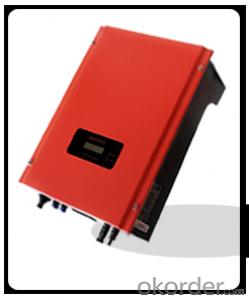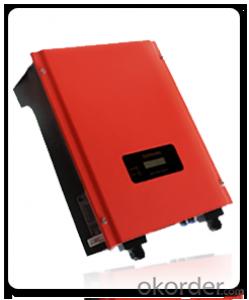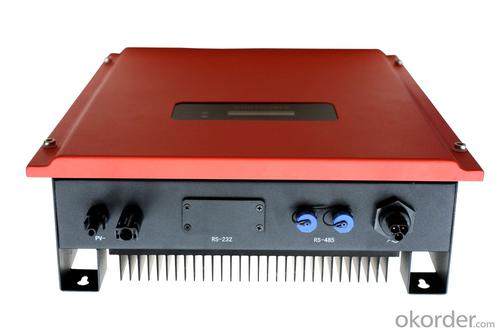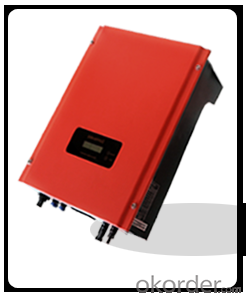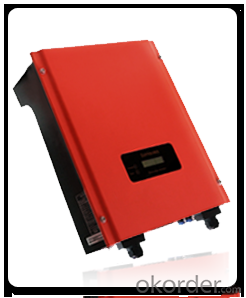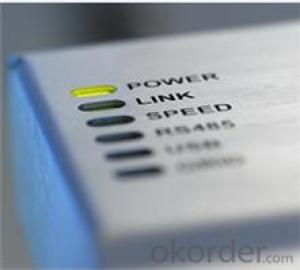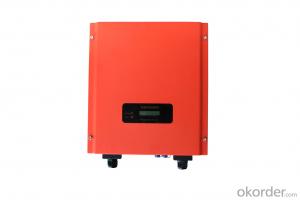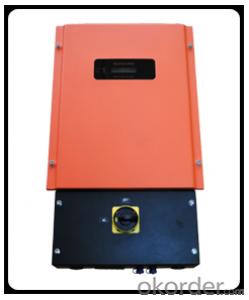Solar Inverters Sunteams 1500 to 3000 US ETL from China
- Loading Port:
- China main port
- Payment Terms:
- TT or LC
- Min Order Qty:
- 1 watt
- Supply Capability:
- 10000000 watt/month
OKorder Service Pledge
OKorder Financial Service
You Might Also Like
Description:
The Sunteams (US) 1500 ~5000 series isapplicable to various rooftops and small scale photovoltaic grid connected power plants. Their nominal output powers are 1.5 kW, 2 kW, 2.5 kW, 3 kW, 4 kW and 5kW respectively with Certificate ETL (220V/60HZ).
This series is transformerless and has a wide range of MPPT input voltage. Itsmaximum conversion efficiency and MPPT tracking accuracy reach 97.6 % and 99.5% respectively. The maximum DC voltage reaches 550 V. Its multilingualLCD display facilitates easy operation. It has waterproof direct plug-interminals. It has overvoltage, islanding, short-circuit, overloading andoverheating protection functions. Its IP65 protection degree will ensure itruns well in various tough environments.
These units are available with or without wirebox.
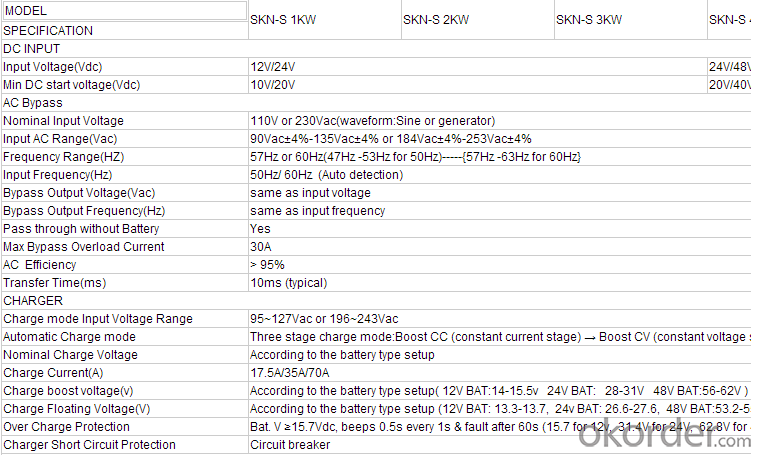
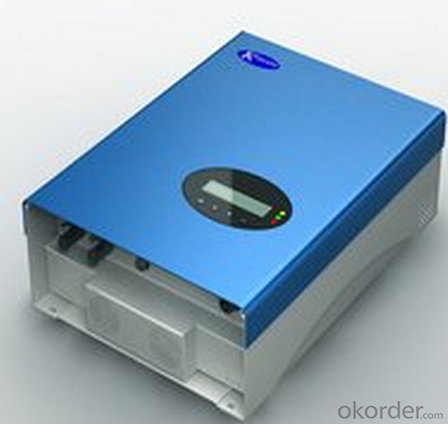
FAQ:Pls introduce more about CNBM?
CNBM is a China state owned company ,one of Global Fortune 500 .
- Q: Can a solar inverter be used with solar trackers?
- Yes, a solar inverter can be used with solar trackers. Solar trackers are designed to follow the sun's movement throughout the day, maximizing the solar panel's exposure to sunlight. The solar inverter converts the DC (direct current) power generated by the solar panels into AC (alternating current) power that can be used in homes or businesses. The inverter can be connected to the solar tracker system to ensure efficient and effective utilization of the solar energy harvested by the panels.
- Q: What is the role of a solar inverter in voltage and frequency regulation during islanding conditions?
- The solar inverter plays a crucial role in maintaining voltage and frequency regulation during islanding conditions. Islanding conditions occur when a distributed generation system, like a solar PV system, continues to supply power to a local area even when the main electrical grid is disconnected. In grid-connected mode, the solar inverter synchronizes its output voltage and frequency with the utility grid. However, during islanding conditions, it must transition into a standalone mode and take responsibility for regulating voltage and frequency within the isolated microgrid. The primary function of the solar inverter in islanding conditions is to ensure that the voltage and frequency of the generated electricity remain within acceptable limits. To achieve this, it constantly monitors the electrical parameters and adjusts its own output accordingly. To regulate voltage, the solar inverter adjusts its output voltage based on demand and the available power from the solar panels. It maintains a steady voltage level within a specified range, typically around 230-240 volts for residential applications. Equally important is frequency regulation, which ensures that the electrical devices connected to the microgrid operate at their designed frequency, usually 50 or 60 Hz. The solar inverter continuously monitors the frequency and adjusts its output to match the required frequency, minimizing fluctuations and maintaining stability. Apart from voltage and frequency regulation, the solar inverter also performs other crucial functions during islanding conditions. These include power quality control, protection against overvoltage and overcurrent, and safe disconnection in emergencies or during grid restoration. Overall, the solar inverter's role in voltage and frequency regulation during islanding conditions is critical for maintaining a stable and reliable power supply within the isolated microgrid. It ensures that the electricity generated by the solar PV system remains within acceptable parameters, enabling connected electrical devices to operate efficiently and safely.
- Q: Can a solar inverter be used with dual MPPT inputs?
- Yes, a solar inverter can be used with dual MPPT inputs. Dual MPPT (Maximum Power Point Tracking) inputs allow the inverter to optimize the power output from two separate solar arrays or strings, thereby increasing overall energy efficiency and system performance.
- Q: Can a solar inverter be used with a solar water heating system?
- No, a solar inverter cannot be used with a solar water heating system. A solar inverter is designed to convert the direct current (DC) electricity produced by solar panels into alternating current (AC) electricity for use in the home or to be fed back into the grid. On the other hand, a solar water heating system uses the sun's energy to heat water directly, without the need for electricity conversion.
- Q: How do I choose the right solar inverter for my system?
- When choosing the right solar inverter for your system, there are a few key factors to consider. First, determine the size and capacity of your solar panels to ensure compatibility. Next, consider the type of inverter you need, whether it's a string inverter, micro inverter, or power optimizer. Additionally, assess the efficiency and reliability of the inverter, as well as its warranty and after-sales support. Finally, consider your budget and any specific features you may require, such as monitoring capabilities or grid connectivity options. It's important to research and compare different models to find the one that best fits your specific solar system needs.
- Q: Can a solar inverter be used in conjunction with a power optimizer?
- Yes, a solar inverter can be used in conjunction with a power optimizer. Power optimizers are devices that are typically installed at each solar panel to maximize energy production and improve overall system performance. They can work together with a solar inverter to enhance the efficiency of the solar power system by individually optimizing the power output of each panel.
- Q: Can a solar inverter be used in areas with unstable grid connections?
- Yes, a solar inverter can be used in areas with unstable grid connections. Solar inverters are designed to convert the DC power generated by solar panels into usable AC power for consumption or to be fed back into the grid. In areas with unstable grid connections, solar inverters can still function and provide power by utilizing battery storage systems or operating in off-grid mode. This allows for uninterrupted power supply and provides stability in areas with unreliable grid connections.
- Q: How does the maximum AC current rating affect the performance of a solar inverter?
- The maximum AC current rating of a solar inverter determines the maximum amount of power that the inverter can convert from DC to AC electricity. If the current rating is too low, the inverter may not be able to handle the peak power output from the solar panels, resulting in reduced performance and potential overheating or failure. On the other hand, if the current rating is high enough to handle the maximum power output, the solar inverter will perform efficiently and effectively, ensuring optimal energy conversion and output.
- Q: How is the size of a solar inverter determined?
- The size of a solar inverter is typically determined by the total capacity of the solar panels it needs to handle. The inverter should have a capacity slightly higher than the total wattage of the solar panels to ensure efficient conversion of the DC power produced by the panels into usable AC power for household or grid consumption.
- Q: How does the size of a solar inverter affect its performance?
- The size of a solar inverter directly impacts its performance. A larger inverter with a higher wattage capacity can handle a greater amount of solar power generated by the panels. On the other hand, a smaller inverter may not be able to efficiently convert and utilize all the energy produced, resulting in a decrease in overall system performance. Therefore, choosing the appropriate size solar inverter is crucial to ensure optimal performance and maximize energy production.
Send your message to us
Solar Inverters Sunteams 1500 to 3000 US ETL from China
- Loading Port:
- China main port
- Payment Terms:
- TT or LC
- Min Order Qty:
- 1 watt
- Supply Capability:
- 10000000 watt/month
OKorder Service Pledge
OKorder Financial Service
Similar products
Hot products
Hot Searches
Related keywords

